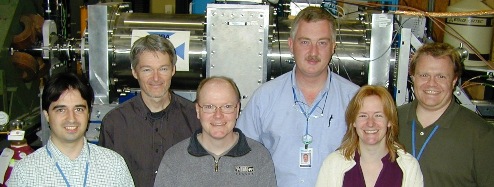The TRIUMF-UK Detector Array (TUDA) collaboration celebrated on June 10 as they completed a three week run using the world’s most intense accelerated 18F beam to investigate one of the most important nuclear reactions occurring in novae. The data obtained will aid in understanding observations made by satellite gamma-ray observatories such as the Gamma-ray Large Area Space Telescope (GLAST), which coincidentally blasted off from Cape Canaveral on the same day the TUDA experimental run finished.
Nuclear physics plays a central role in understanding stars. One of the clearest illustrations of this is the stellar explosions occurring on the surface of white dwarf novae. The explosions are a result of a thermonuclear runaway, which occurs when hydrogen from one star builds up on the surface of a companion white dwarf star. Traditional observations of these events reveal great detail, but often only observe the chemical abundances of the aftermath. In contrast, a gamma-ray observation would be able to identify the abundances of some individual isotopes. This will allow for much more rigorous testing of explosion models. Since the earth’s atmosphere clouds observations, the observations will need to be made by satellites. Consequently, this is one of the goals of missions such as NASA’s Compton Gamma Ray Observatory (CGRO), and European Space Agency's INTErnational Gamma-Ray Astrophysics Laboratory (INTEGRAL) and GLAST.
The gamma-ray emission from novae is dominated by the beta-decay of the isotope 18F (fluorine atoms, but containing one less neutron that usual). Flourine-18 has a half life of 110 minutes, and decays by the emission of positrons (positively charged electrons). These positrons then annihilate with the electrons of other atoms. Each annihilation leads to two 511 keV gamma rays: it is this emission of these gamma rays that the satellites hope to capture. The number of gamma rays emitted depends on the amount of 18F produced, which in turn depends on the rates of the various nuclear reactions taking place. Some of these nuclear reaction rates still need to be determined, and the most important of these is 18F(p,α)15O, (where a 18F and a proton are changed into an alpha particle and a 15O ion.)
The development of an intense radioactive ion beam of 18F particles is a major achievement for the Isotope Separator and ACcelerator (ISAC) of TRIUMF. By making this beam incident on a polyethylene foil, scientists of the TUDA collaboration have been able to make a direct measurement of the 18F(p,α)15O reaction. Highly sensitive silicon detectors were used to detect the resulting alpha particles and 15O nuclei when 18F ions reacted with the protons of hydrogen atoms in the polyethylene. The intensity of the beam reached about 10 million particles per second. This intensity makes it the most intense such beam in the world and allows for the first time measurements to be made at energies of particular interest for resolving the astrophysical uncertainties.
Please visit theTUDA group website.
If you are interested in more information, please contact the spokespersons for the experiment: Alison Laird, University of York, UK (al34@york.ac.uk), or Alex Murphy, University of Edinburgh, UK (a.s.murphy@ed.ac.uk)
By Pat Walden
TRIUMF Research Scientist

Banner photo: From left to right Marco Marchetto (TRIUMF), Bob Laxdal (TRIUMF), Alex Murphy (Edinburgh), Tom Davinson (Edinburgh), Alison Laird (York), Colin Morton (TRIUMF) in front of the TUDA chamber.
